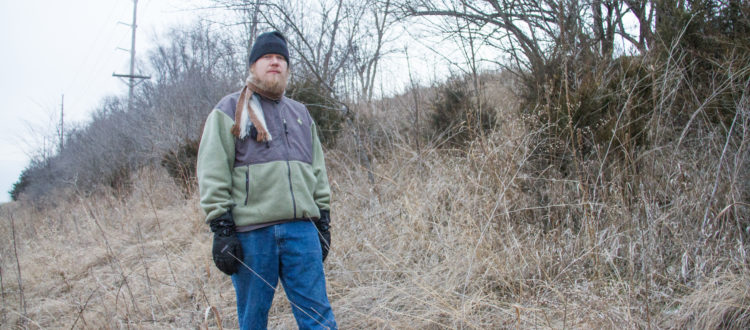Landowner, Electric Utility, and County Conservation Partner in Oak Savanna Restoration
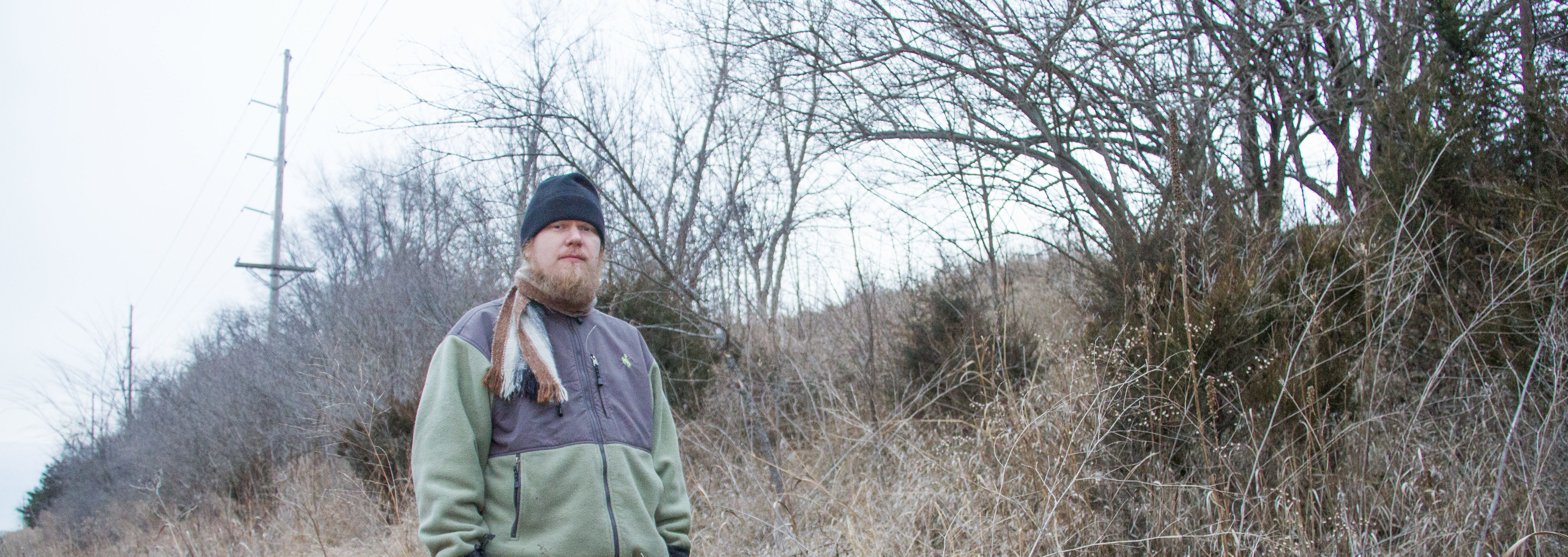
Paul Hertz’s native oak-hickory savanna was given new life after a collaboration with utility company ITC Midwest and a county vegetation management biologist.
It started ordinarily enough, with a call from regional transmission utility ITC Midwest. The trees on Paul Hertz’s farm near Nevada, Iowa were growing close to the electric line, and it was time to prune back the branches.
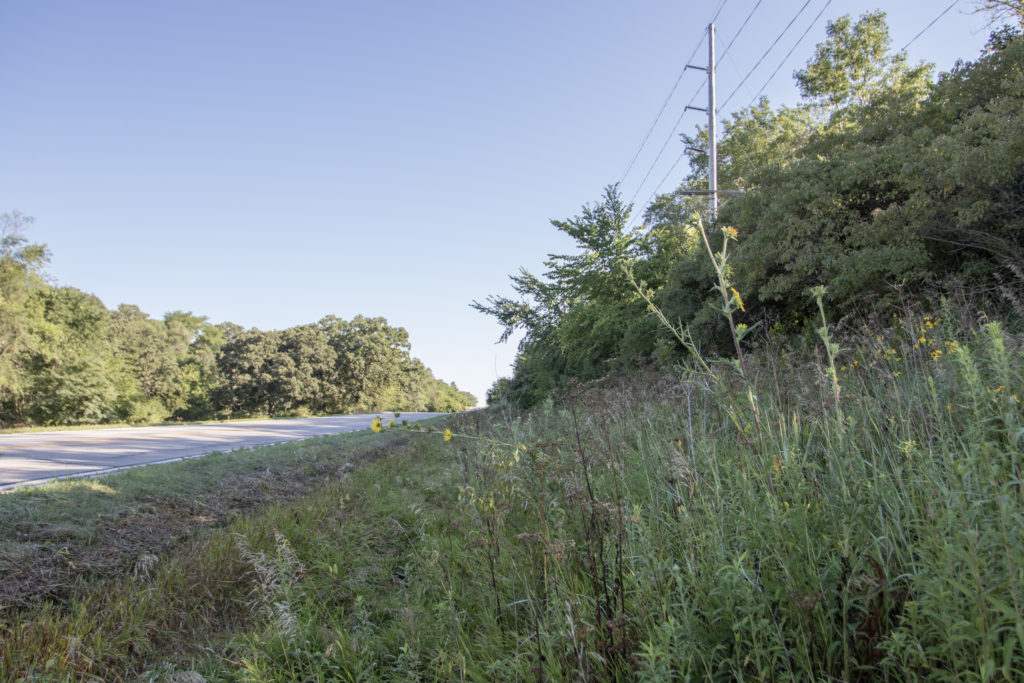
Compass plant emerges from remnant prairie growing between highway and electric lines. (August 2017)
In the long, narrow four and a half acre strip of land beneath the transmission lines, an oak savanna and prairie remnant had been identified. A recent land assessment had revealed native oak and shagbark hickory trees, unnoticed in the tangle of branches from fast-growing invasive honeysuckle and other undesirable species. Just a few feet away, a small remnant prairie was growing in the Story County right-of-way along the edge of the highway.
Paul had spent his early childhood on this farm, running around the woodlands with his dad–an avid lover of the outdoors. He inherited his father’s curiosity and care for nature, and when Paul became the primary steward of the land, he wanted to manage not only the farm fields, but the woodlands that surrounded them.
“I wanted the woods to be something that I could enjoy in the same way as when I grew up on the farm,” explained Paul. “I knew that doing nothing would degrade the land further in terms of honeysuckle or desirable trees not being replaced.” After connecting with Luke from Prudenterra, Paul asked him to conduct an ecosystem assessment to learn about the composition of his woodlands, and opportunities to manage them.
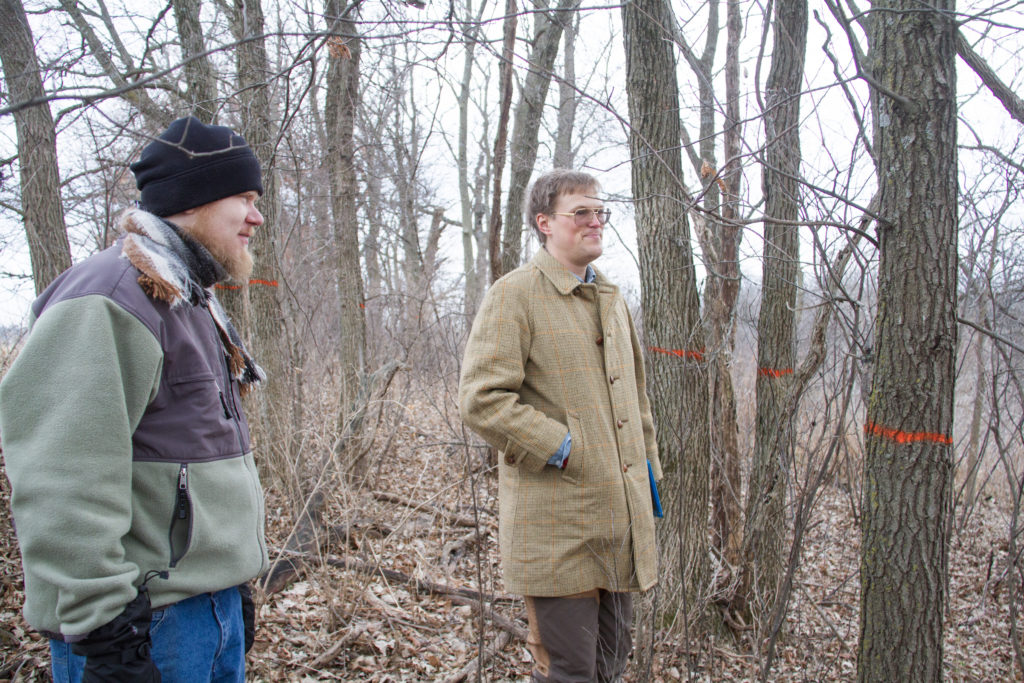
Paul and Luke survey red-banded trees marked for retainment. (January 2017)
Following the recommendations of the assessment, Paul decided to stagger the management over several years, starting first with the highest quality oak-walnut stands. Eventually, he planned to restore the savanna and prairie remnant that had been identified underneath the transmission lines.
But when ITC Midwest contacted him about pruning, he wondered if their cutting could help him work closer to restoring the remnant savanna and prairie. “The idea of getting several years of work done at once was immediately appealing,” Paul reflected. “When Story County Conservation got added to the mix it became especially intriguing, since they had a special interest in the county land by the highway.”
Joe Kooiker, Vegetation Management Biologist with Story County Conservation, had been monitoring the site since the late 1980s when the Integrated Roadside Vegetation Management program first began. He had identified several native prairie indicator species, among them, hoary puccoon, leadplant, and compass plant. To keep the remnant intact over the decades, Story County Conservation had conducted a couple of prescribed burns, and removed woody vegetation along the roadside.
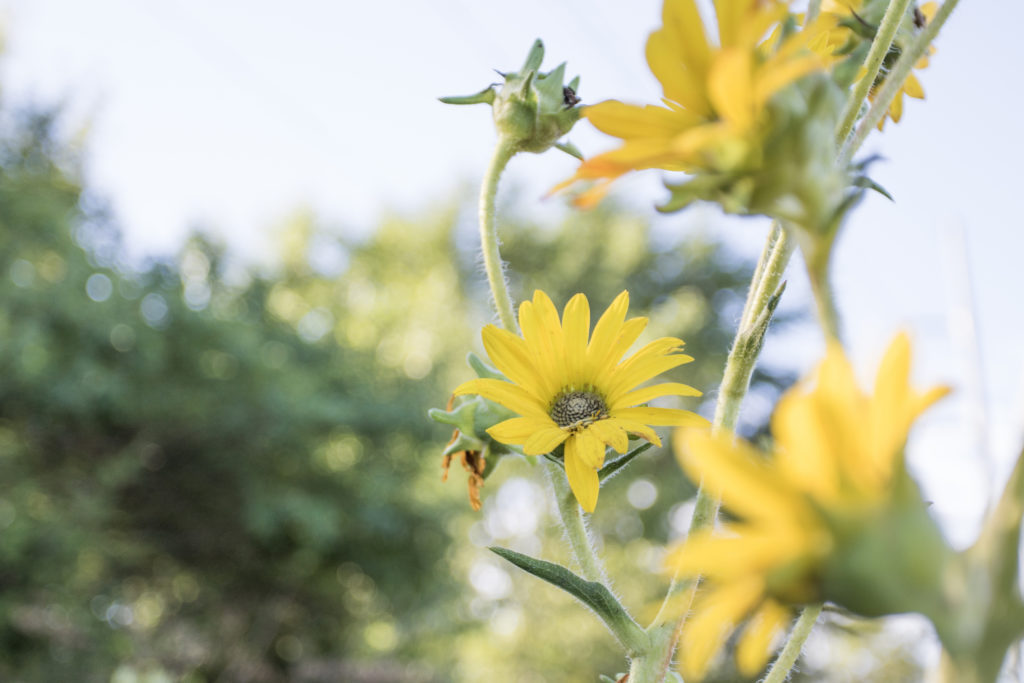
Remnant indicator: Compass plant (Silphium laciniatum) blooms along the roadside near Paul’s savanna.
The biologist is looking forward to seeing the savanna restoration unfold, noting, “It will be interesting to see what comes back with the added light.” Joe is enthusiastic about the collaborative nature of the project. “Now that we are all connected, it will make it easier to manage.”
Prairie and savanna restoration was also an appealing option for Troy Weary, Area Manager at ITC Midwest, the company responsible for maintaining line clearance. He was excited to see how a higher up-front investment could reduce long-term utility line maintenance while supporting the company’s environmental initiative.
Utility Forester, Chip Murrow explained that the area underneath the transmission lines on Paul’s land contained fast-growing trees like hackberry and elm that had to be pruned every three years. “The forester in me was excited about the savanna project–I like to see restoration projects, and it means we won’t have to go back and do as much vegetation work. Oaks and hickories are slower growers, so if we do have to do maintenance, we won’t have to take as much off. It’s a win-win both ways.”
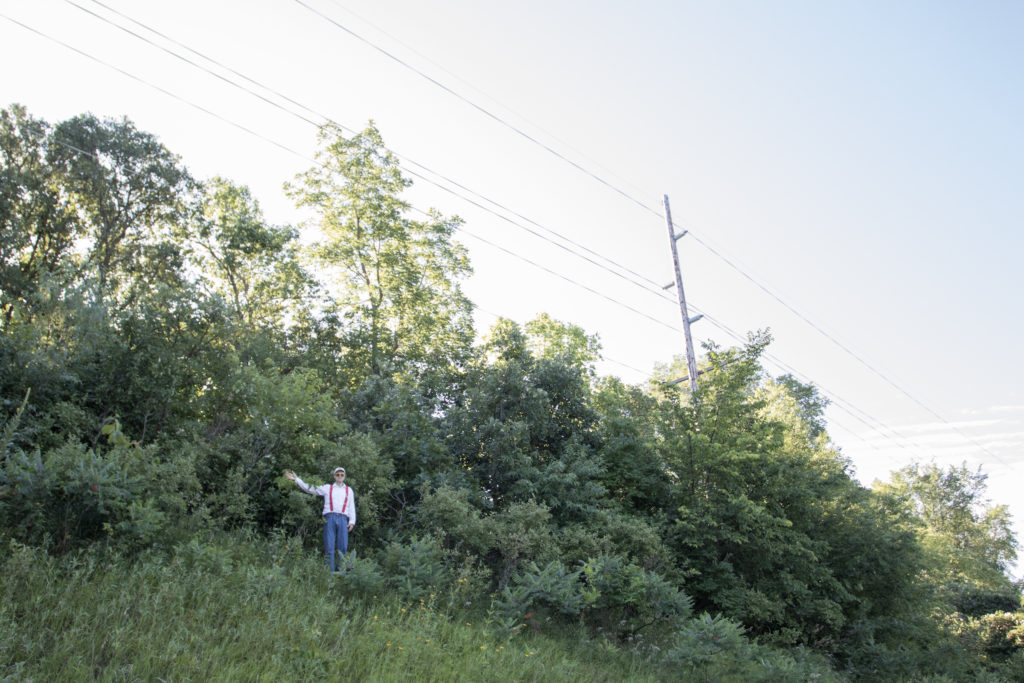
Undesirable trees and invasive honeysuckle masked remnant oak and shagbark hickory trees, and crowded transmission lines. (August 2017)
Troy Weary added, “In order to be successful for everyone, collaborative efforts are incredible for environmental purposes. I love projects like this that work with the landowner to improve conservation while supporting our mission of providing safe, reliable power.”
For Paul, these were complementary objectives to his goals of improving environmental stewardship, beauty, and biological diversity. Since the tree and shrub removal component would be at no cost to him, it would enable him to move forward much more quickly on the restoration. He saw it as an opportunity to taper the woodland-cropland transition, and reduce soil erosion and gully formation with densely rooted native prairie plants.
As the forester who conducted the initial assessment and would be overseeing the non-cutting aspects of restoration, Luke was thrilled. The project would enable oaks and hickories to regenerate, and help keep invasive species in check. An added bonus–more sunlight would reach the adjacent prairie pollinator habitat enrolled in the Conservation Reserve Program (CRP).
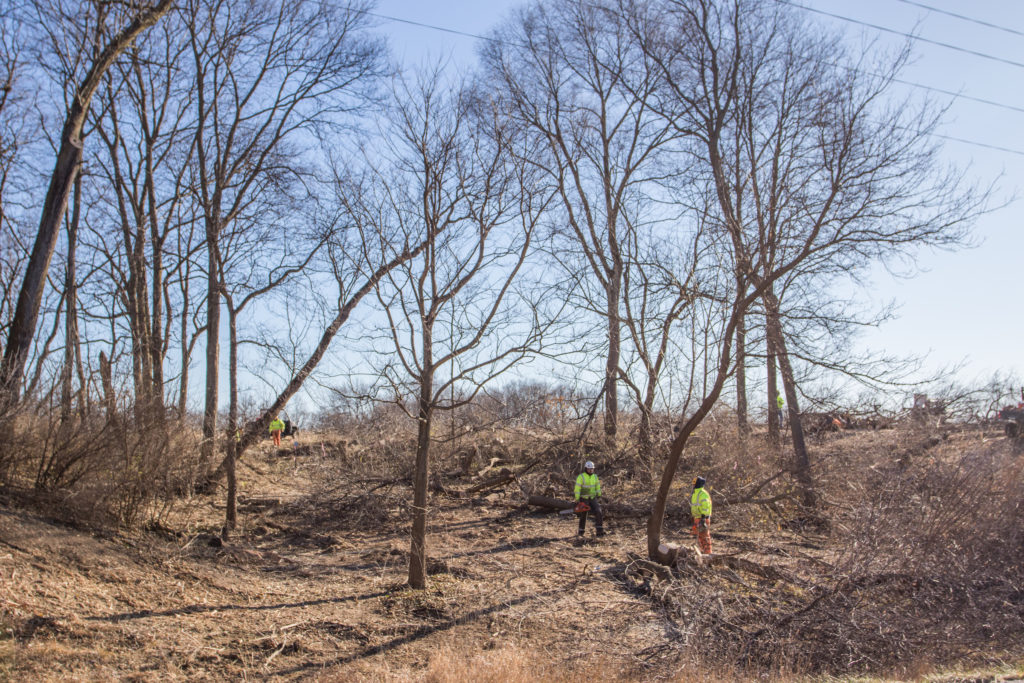
The ITC Midwest crew spent three weeks removing invasive honeysuckle and less desirable trees (cherry, honeylocust, elm, ash, and basswood). (December 2017)
On a frosty morning in December of 2016, Luke facilitated a gathering with Paul and the other stakeholders–Randy, his farm manager from Hertz Farm Management, Joe from Story County Conservation, and Troy and Chip from ITC Midwest. Overlooking the savanna from the warmth of a running vehicle, they worked out a common vision and plan of action.
Luke would mark desirable trees with a band of red paint to indicate that they should be retained. That fall, the ITC crew would remove the unmarked trees and shrubs–the undesirable species. Then, prescribed burns would be conducted in 2018, 2019, and 2020 (and then periodically for maintenance) to kill invasive species and promote oak regeneration and prairie vigor.
A dramatic change in the landscape began in late November of 2017, as the crew from ITC Midwest arrived with chainsaws, wood chippers, skid steers, and bucket trucks to propel the restoration into action. For three weeks, they cut, chipped, shredded, piled, and pruned. Neighbors even pitched in, helping to haul away elm, ash, mulberry, and hackberry firewood from the site to reduce fuel load (and smoke on the highway during burning) and speed up the restoration process.
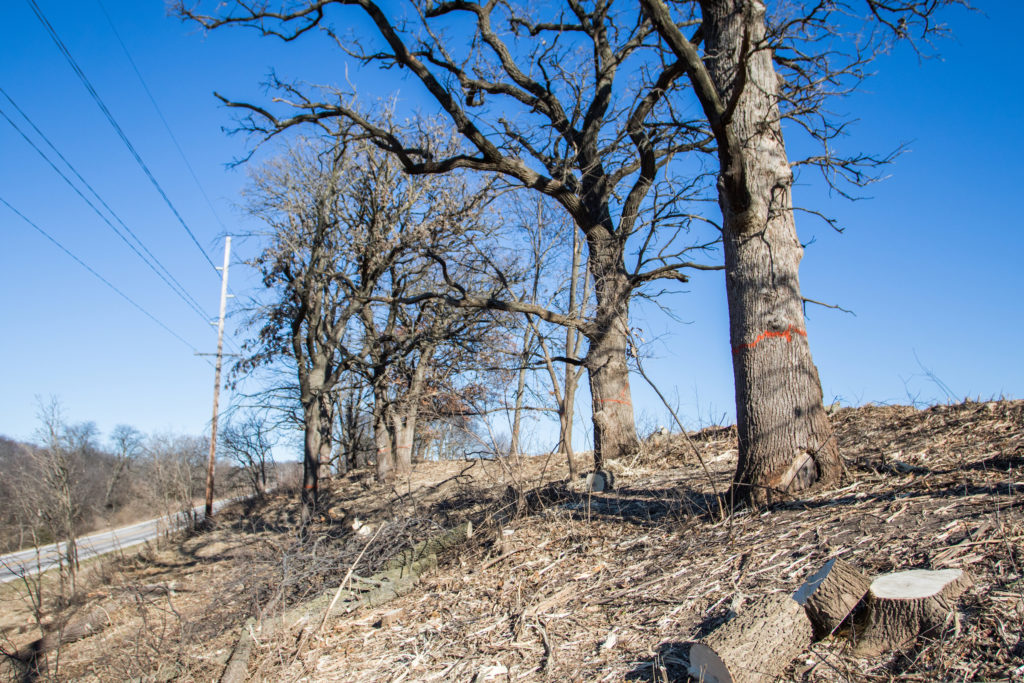
Post-restoration, the shagbark hickories and bur, white, black, and red oaks have sufficient sunlight to begin growing healthier lateral branches. (December 2017)
The spare aesthetic of a recently restored savanna can sometimes surprise landowners who have become accustomed to a dense woodland. Paul recalled, “In the past, that area has felt far too cluttered, with so much undergrowth–probably the honeysuckle.” He notes that it was a big change on the landscape, but, “One thing I like about it already is that I have a much better view. With things more open, it is a very nice walk along there, and you can see in all directions now; beautiful woodlands of various types–my central woods, the savanna pasture across the road, and the rest of the East Indian Creek valley.”
Over the long-term, Paul is glad to have another ecosystem represented on his farm, but his connection to the land extends far beyond that. “I would like to enjoy more native plants there and see the changes and increase in diversity. My dad made a point of knowing the names for many different plant species out there, and that is something I would like to learn as well.”
Since ITC Midwest first contacted Paul back in 2016, the remnant beneath the transmission lines has become a perceptibly different kind of woodland. Paul is excited to see the new growth return to the trees this spring as they begin to reclaim and fill in the space, refined by coming years of prescribed fire.
As a relatively young landowner, Paul has the opportunity to take a long view of the growth of the woodland. “There are other trees on the property where I can look back and see the difference between my childhood and now. I think it will be nice in the long-term to see that with the oaks as well, and see them change over time.”

